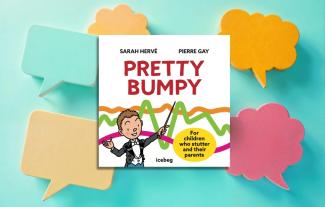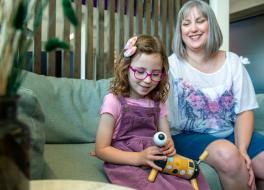Book review: Bumpy Speech

Members of the STAMMA volunteer review team share their thoughts on a new book for children who stammer and their parents.
Pretty Bumpy is a new book that approaches stammering in a positive way, aimed at children who stammer aged 3 to 8 and their parents/guardians.
Written by speech & language therapist Sarah Hervé, translated from the original French version and with illustrations by Pierre Gay, the book is split into two sections. The first part is for children and the second part is aimed at adults, and it includes a game for everyone to play.
We asked parent Leanne Vidamour and her daughter Scarlett, aged 9, as well as speech & language therapist (SLT) and parent Katherine Brown to tell us what they think.
The part for children
Leanne (parent):
Pretty Bumpy introduces us to a character called Alex, who describes to the reader what it's like to stammer, or have 'bumpy speech' as he calls it. The Tintin-esque pictures are bright and grab your attention quickly. It is clearly written and gives children the whole picture on how stammering can be big or small and that every day can be different. It also prompts children to think about their own feelings about stammering, helping them to talk about it.
As a parent, what really stood out for me was the constant use of positive words and phrases such as, "I'll get there and what matters most is getting your message across". Such positive reinforcements are super important for children, and embedding them early can help to provide them with resilience and confidence around their stammer.
Scarlett (aged 9):
Reading about Alex reminded me how I feel sometimes and I thought 'yeah, that's me'. My favourite parts were how confident Alex was and how he said, '…then often, I just don't care and say everything I want to say', because that's me too!
Tell us about the game
Katherine (SLT & parent):
After describing what it's like to stammer, Alex invites readers to play a game where one player describes a picture while another presses buttons labelled 'big bumps', 'small bumps' or 'flow smoothly'. Every time one of the buttons is pressed, the person describing the picture has to adjust their speech to match the button. For instance, if the 'big bumps' button is pressed, the player is encouraged to talk with lots of bumps. Players take turns and then reflect on the game, allowing them to consider how it feels to speak in different styles.
What did you think of the game?
Leanne:
The game allows children to have fun with their stammer and gives them and their parents the opportunity to take turns using bumpy speech and ask questions around it. This is a great way to talk to others about stammering and really communicate different ways in which people can speak.
Scarlett:
The game was a little confusing at first but when I played it with my family it was fun. It allowed them to speak bumpy like me!
Katherine:
One of the goals of the author, a speech therapist herself, is to desensitise stammering, and with the game's 'bumpy speech' from all participants, it feels as if she achieves this. The game also creates an equal playing field for fluency, which is rare, and could be empowering for a child who stammers.
Although the instructions are clear and the idea straightforward, there is no guidance on how long to play or how many times to press the buttons, nor is it a game with a winner. Some children may benefit from more detailed direction or an end goal to maintain their interest, so it would be helpful for an adult to be present to adapt the game to suit the ages and capabilities of the players.
As parents, our main concern is for the wellbeing of our children, and this excellent book contributes to this.
(Leanne)
Play is a wonderful way to engage children, and inspiring children to consider and adjust their own talking can encourage self-awareness, which is always worthwhile. Moreover, for a child with a stammer, practising adjusting their speech could be beneficial — some may find themselves modifying their speech in the future, either of their own accord, or with a supportive adult or therapist.
It's worth considering, however, that some children might find it stressful to consider their speech, let alone try to change it on demand, and might not enjoy the game. In this scenario, it could be amended — for example, the child with a stammer could choose the button to press for their own speech adjustments. Of course, the key to receiving benefits from play is that activities remain fun — the book makes clear that this is the aim, but again, it would be beneficial for an adult to be present to ensure that the game remains on friendly ground.
The part for adults/guardians
Katherine:
The second part of the book is aimed at helping adults understand how to support a child with a stammer. It gives clear strategies on how to approach communication successfully, and how to keep the experience positive. Practical, easily transferrable advice such as this gives parents tools to manage everyday scenarios, and this is an essential part of supporting families.
This part also points out that speech and language therapy may also be helpful and provides contact details for some useful support organisations.
Leanne:
The tips for parents and guardians are clear and concise, with pictures that model them well. They explain what stammering is and take away any blame that parents might be feeling whilst giving confidence and reassurance to help them see they're not alone when their child stammers.
I found the fact that the author is a speech & language therapist, together with the list of organisations she provides at the end to reach out to, extremely helpful and reassuring.
To sum up
Scarlett:
I really enjoyed this book because it was really fun and positive. It gives a great message that it's okay to stammer.
I think the book's good for people starting out their journey and for people to look back on. It would be great to have in libraries for those who don't know anything about stammering, and they could use it to help communicate positively. It's a 10/10 from me!
Leanne:
As parents, our main concern is for the wellbeing of our children, and this excellent book contributes to this. The way the author encapsulates the journey children and adults take with stammering is excellent and the book is a must-read, which in my opinion should be in every library and school.
Katherine:
All in all, I would have no hesitation in using this book in therapy, and with my child. The over-riding messages it presents — that we should normalise stammering, de-stigmatise it, and consider it within a positive frame — are all essential themes.
But the book's success is dependent on it being an active book, rather than a passive one. That is to stay, having a sensitive adult alongside to make sure that it is used as intended. With this in place, Pretty Bumpy could be an be an excellent resource, making communication more enjoyable all round, and setting the tone for how to support a child with a stammer, and their whole family.
Pretty Bumpy by Sarah Hervé is a self-published book and is available to buy now on paperback from Amazon.
Thank you to Leanne, Scarlett and Katherine for reviewing this book for STAMMA.

































